Tom's Guide Verdict
The Moto G is an excellent budget Android phone, sporting a chic design, a bold 5-inch display and all-day battery life.
Pros
- +
Bright, accurate display
- +
Solid overall performance
- +
Long battery life
- +
Useful Moto Actions app
- +
Customizable design
Cons
- -
Slightly heavier than competition
- -
Camera struggles in low light
Why you can trust Tom's Guide
There are phones that are "good enough,” and then there are phones that are great. The new Moto G, which starts at just $179 unlocked, is in the latter category. A significant upgrade from last year's model, this sequel adds 4G LTE support, a brighter display, a longer-lasting battery and a much-improved 13-megapixel camera. The $219 model we tested increases the included storage from 8GB to 16GB and the RAM from 1GB to 2GB, which to us is worth the extra 40 bucks. It's all wrapped up in a water-resistant design you can customize. It doesn't get any better than this for those on a budget.
Design
Motorola didn't mess too much with the Moto G's already solid design. The phone has a sturdy plastic body, now featuring a thin, ribbed texture on the curved back plate.
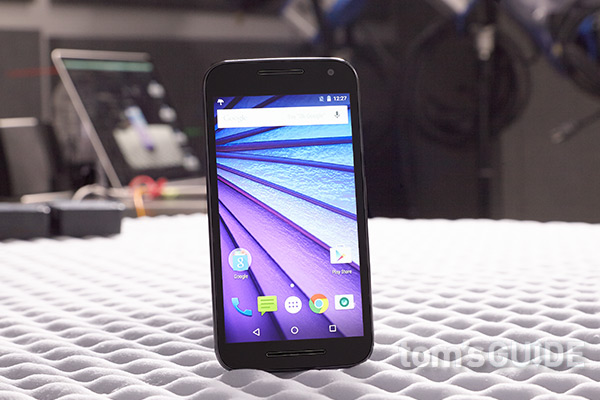


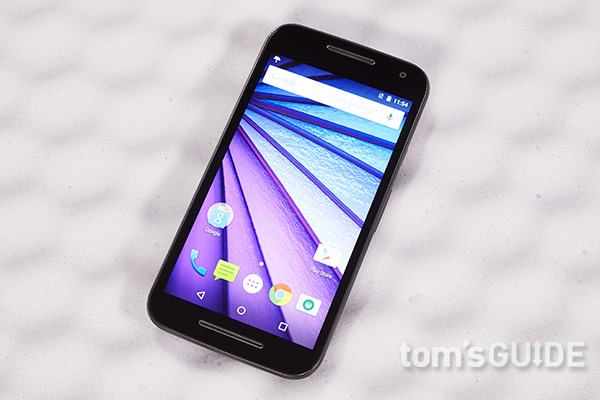


Also new to the back is a long, oval metallic accent that hugs the rear camera lens and flash, and extends down to the Motorola logo in the middle of the back.
The front of the handset still has thin bezels surrounding the 5-inch display. There are slim speaker grills at the top and bottom of the device, and a camera sits in the top right corner.
MORE: Best Smartphones on the Market Now
It's the customization options that give the inexpensive Moto G its high-end flair. My review unit came with white a back with silver accents, but you can fully customize the phone's look via the Moto Maker website. There, you can choose from among 10 back colors and accent colors, ranging from Lemon Lime to Light Chrome, as well as two front colors (white or black). All of these options are free, but it will cost you extra if you want to buy a protective shell ($29.99 in five colors) or get the handset engraved ($5).

The new Moto G is definitely tougher than its predecessor. It's now IPX7 rated, which means it can withstand being submerged in up to 1 meter of water for 30 minutes. Bonus: There's no annoying port cover to get in your way.
Get instant access to breaking news, the hottest reviews, great deals and helpful tips.
The Moto G measures 5.5 x 2.8 x 0.45 inches and weighs 5.45 ounces, which makes it heavier than some unlocked phones in the same price range. For instance, the Blu Life One (5.6 x 2.8 x 0.3 inches, 4.3 ounces) is more than an ounce lighter, while the Nuu X1 is taller than the G but lighter (5.8 x 2.8 x 0.38 inches, 5.1 ounces).
Display
The 5-inch, 1280 x 720-resolution display on the Moto G is covered in Corning Gorilla Glass 3 to help prevent scratches. It's a bright and beautiful screen, delivering Florida Georgia Line's live music video for "Anything Goes" with bold colors and sharp details. I could see every drop of sweat on the musicians' brows as they performed on stage, and their light-show background was full of rich reds, oranges and purples. The Moto G's viewing angles aren't the best, as the screen washes out just a bit when you tilt it to the side, but that's a nitpick for a phone in this price range.

The Moto G's display registered 463 nits on our brightness test, which beats the category average (388 nits) and the Nuu X1 (314 nits). The Blu Life One, however, was brighter (525 nits).
This phone also shows off a wide range of colors, scoring 103.3 percent on the sRGB color gamut scale. That's better than the Nuu X1 (88.2), but a tad behind the Blu Life One (104.1 percent). No phone in this class delivers more-accurate hues, as the Moto G notched a Delta-E score of 0.85 (closer to 0 is best), beating out the smartphone category average (4.29) by a long shot.
Moto Assist
The Moto G includes Moto Assist, which makes your phone more location- and context-aware. You can save different locations, and your smartphone will act accordingly, depending on where you are and the time. For example, when you're driving, you can have Moto Assist read your text messages to you, and when you're at work, the phone can be completely silenced.
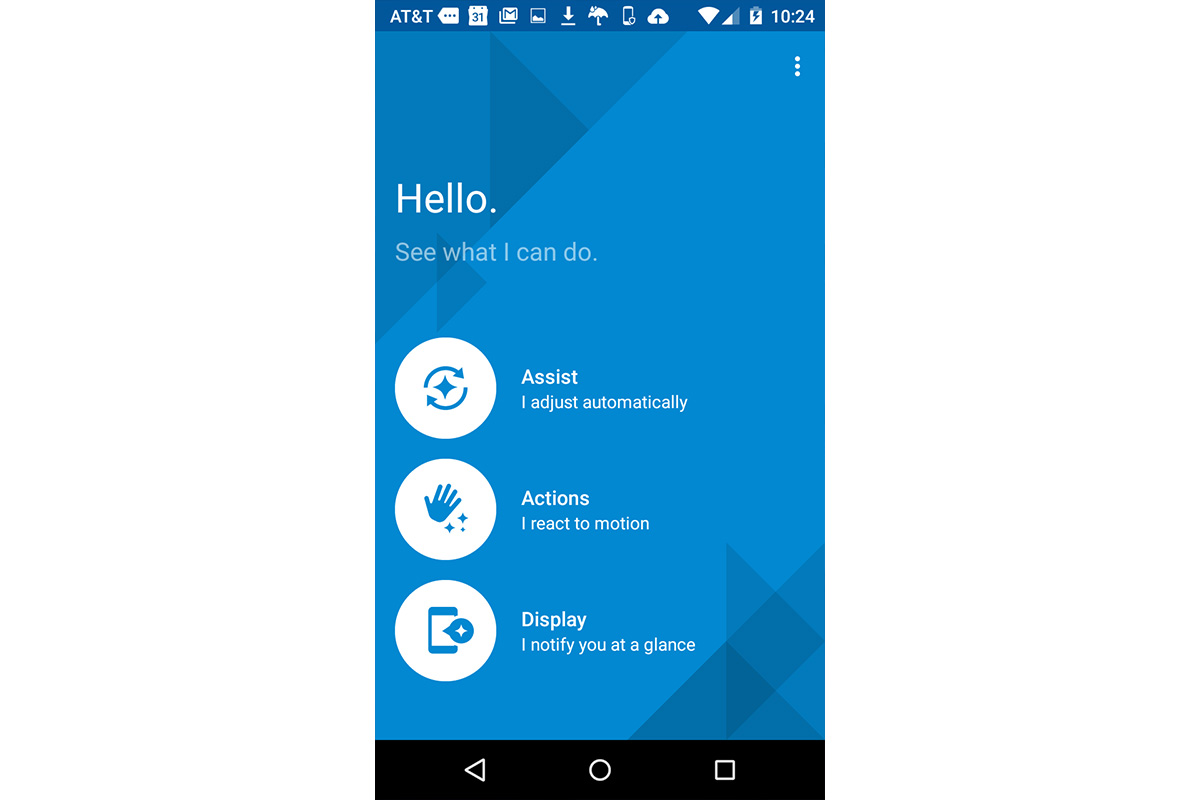
You can also set preferences for when you're sleeping or in a meeting. Moto Assist can keep the screen turned off when you're fast asleep, so alerts won't disturb you, and the feature can send automatic replies when it knows you're in a meeting based on your connected calendar.
Moto Display is another handy feature, which uses your ambient lock screen to show you notifications. You can pick which apps you want to receive notifications from when the screen is locked, and choose how much detail you want to read in each alert. All of this helps save battery, since the display isn't fully on when you read notifications and you don't have to unlock the Moto G to get that information.
Performance
Powered by a 1.4-GHz quad-core Snapdragon 410 CPU and an Adreno 306 GPU, the Moto G runs smoothly even with multiple apps open. This could be because our unit packs 2GB of RAM, compared to 1GB for the $179 version. I never experienced any lag or hiccups while watching YouTube videos or switching among 10 Chrome tabs. The camera launched quickly, too; it was ready to fire in 1.7 seconds.

The Moto G also ably handled games such as Mortal Kombat and Mission Impossible: Rogue Nation, complete with slow-motion kill shots. Even with multiple enemies on the screen in Bombsquad and lots of explosions, the game didn't stutter.

On the Geekbench 3 test, which measures overall performance, the Moto G notched 1,591. While that's lower than the smartphone category average (2,511), it bested the Blu Life One (1,449, 1.2-GHz quad-core Snapdragon 410 CPU) and the Nuu X1 (1,108, 1.2-GHz quad-core Snapdragon 400 CPU).
For our video-editing test, which involves converting a 204MB, 1080p video to 480p in the VidTrim app, the Moto G finished in 8 minutes and 24 seconds. That's faster than the Life One (10:04) and the Nuu X1 (12:39).
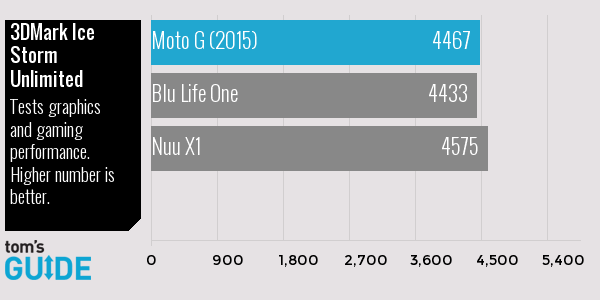
In terms of graphics performance, the Moto G hit 4,467 on the 3DMark Ice Storm Unlimited test, which is better than the Life One (4,433). However, the Nuu X1 (4,575) beat the Moto by a hair.
Software and Apps
The Moto G runs nearly stock Android 5.1 Lollipop, giving the phone a clean, modern interface that shows off Google's Material design nicely. There is zero bloatware.
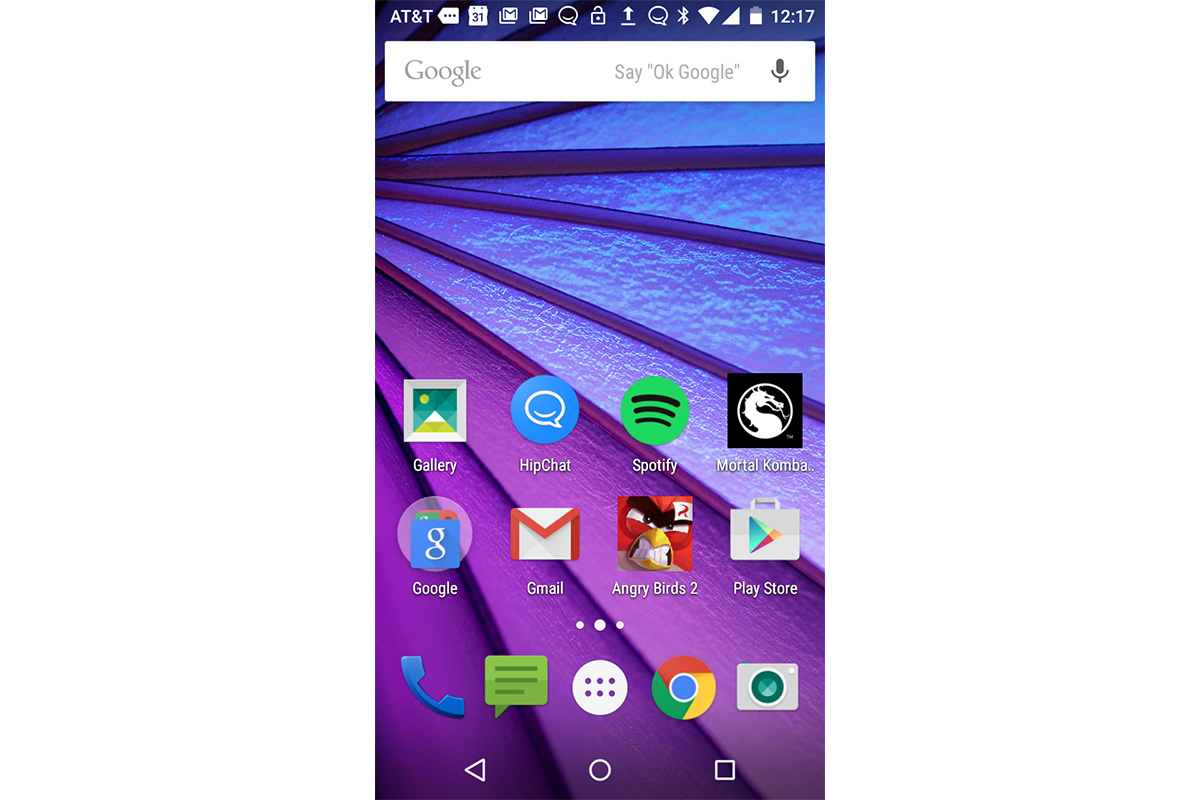
On the dock are standard app shortcuts for tools like Phone, Messages, Chrome and Camera, and there's the menu icon right in the middle for easy access to all your installed apps.
Right above that is a shortcut to the Google Play store, and a folder of Google-specific programs including Gmail, Maps, YouTube and Hangouts. At the very top of the home screen is a Google search bar, which also holds a voice-control button that you can tap to speak a question.
Swiping to the right brings up the Google Now screen, filled with info cards showing you transit directions, nearby restaurants and articles you may want to read based on your search activity.

I appreciate the small ellipsis at the top right corner of each card, which you can use to tell Google if you're interested in receiving similar info cards. This let me praise Google Now for recommending Dough donuts in my nearby eateries and shake my head at it for suggesting an article about Taylor Swift.
From the lock screen, the Android and the Moto G make it easy to access some of the most important tools. You can swipe right to make a call, swipe left to open the camera and swipe up to unlock the screen.
Voice Recognition
In the same fashion as the previous Moto G, the new model lets you speak to it and ask Google Now's voice assistant questions. As you speak questions, the assistant translates your voice into text on the screen, and then will speak answers to you as it brings up Google search results. The voice assistant was quick to process my questions and answered me within seconds. Simply by asking, "Did the Red Sox play last night?" I heard the score from the most recent game — not surprisingly, they lost.
Cameras

Motorola took the 13-megapixel camera sensor from the Nexus 6 for the Moto G, and I was generally impressed with the results.
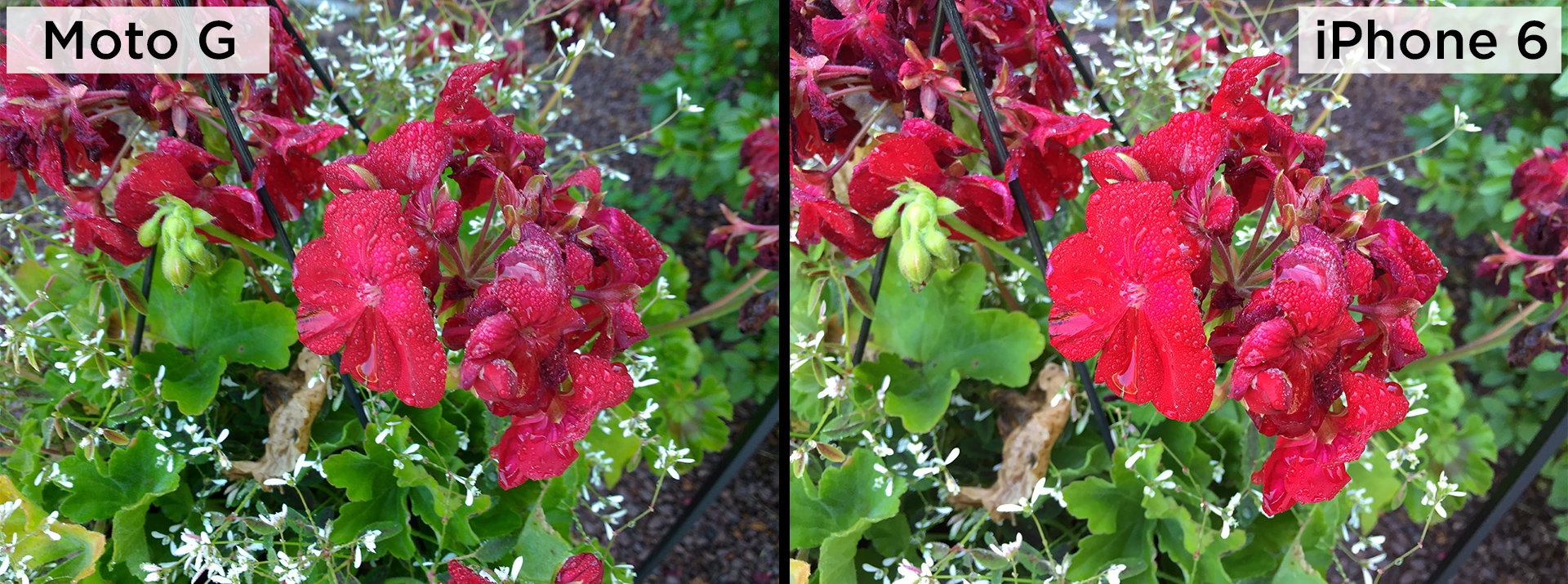
I could make out droplets of water on a close-up of a red flower, although the surrounding leaves looked a bit out of focus.
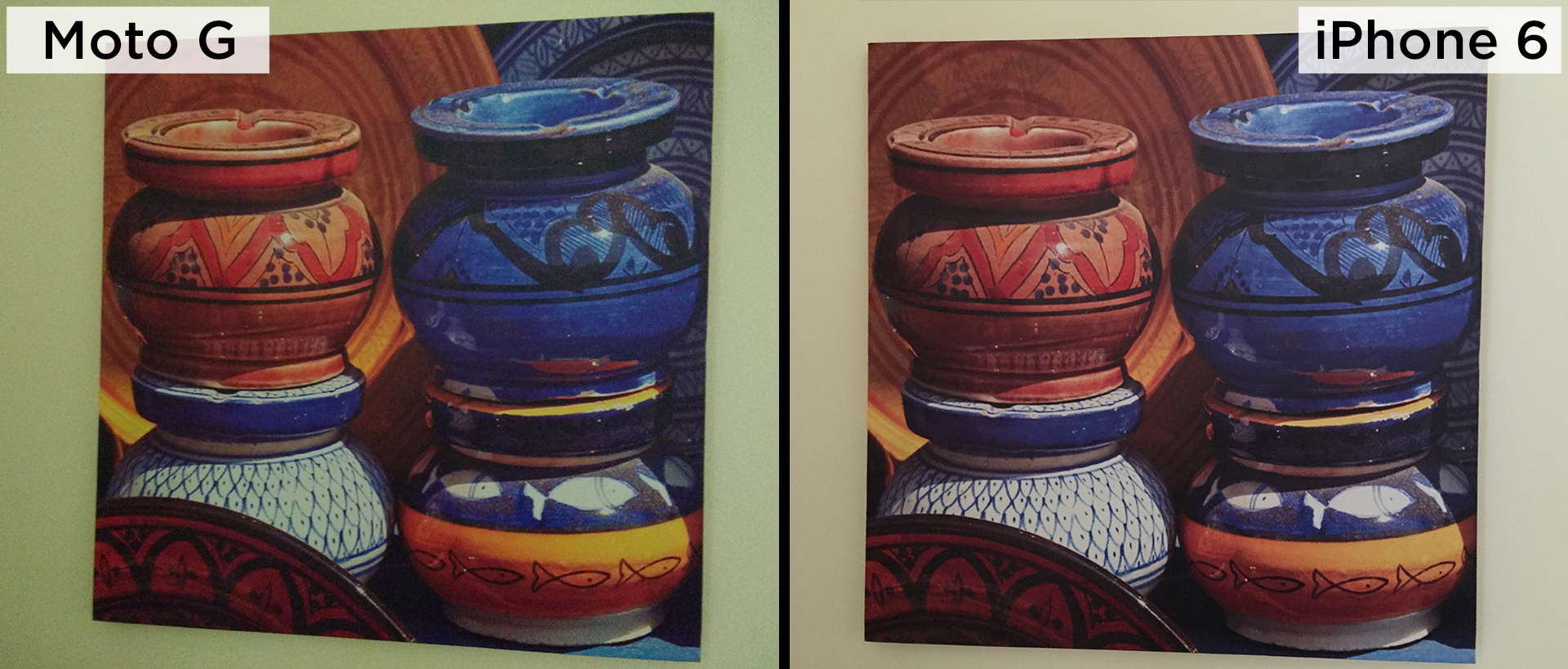
I also took a photo of a pottery picture side by side with the iPhone. The Moto G's image looked fairly sharp, but there was a greenish tint on the wall. That wasn't the case with the iPhone 6, whose photo looked more accurate.
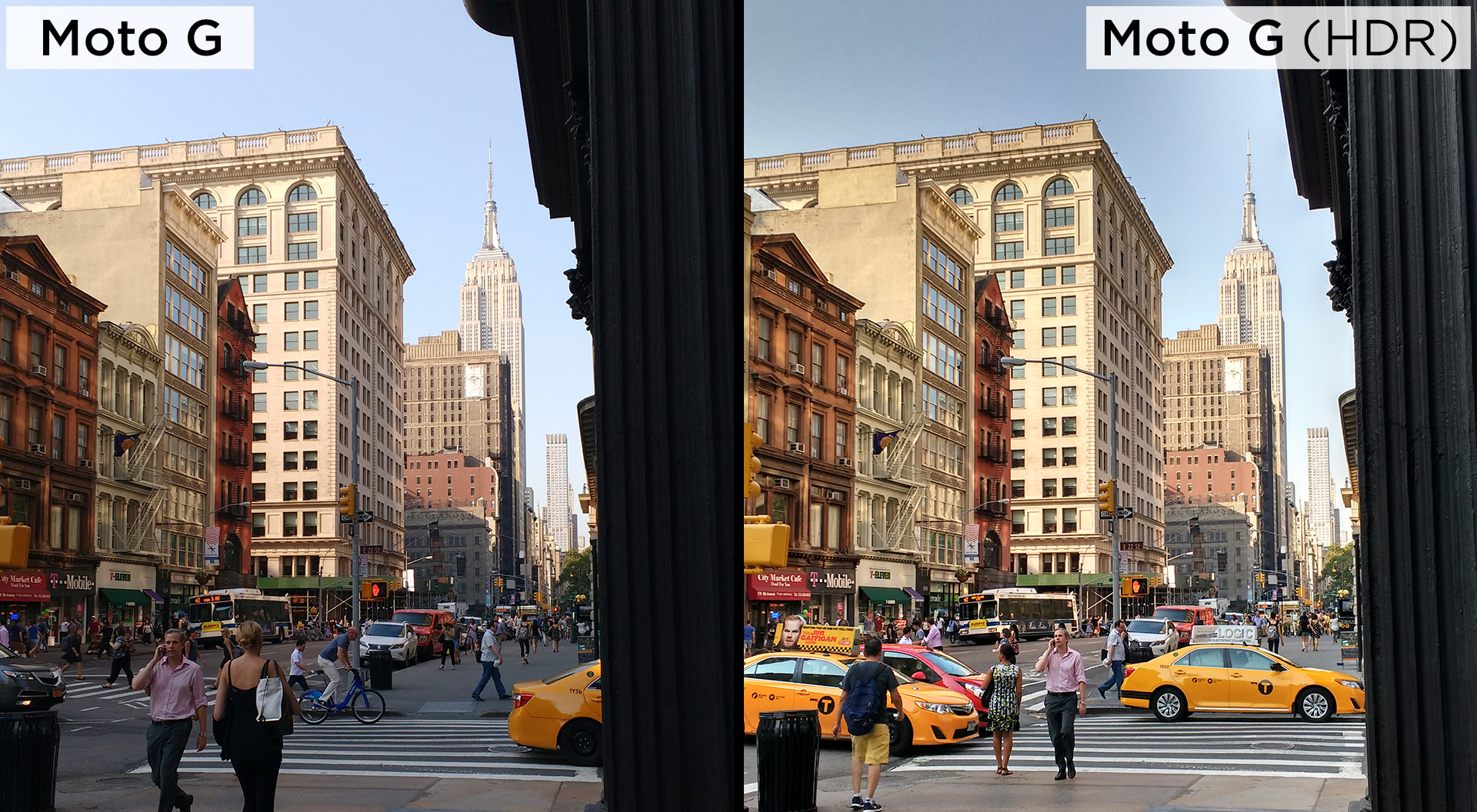
In another shot I took of buildings in New York City during the evening, the Moto G captured a crisp image of passersby, including someone riding on a Citi Bike. I would recommend turning HDR off, though, as it made the buildings look more cartoonish, with pastel-like coloring.
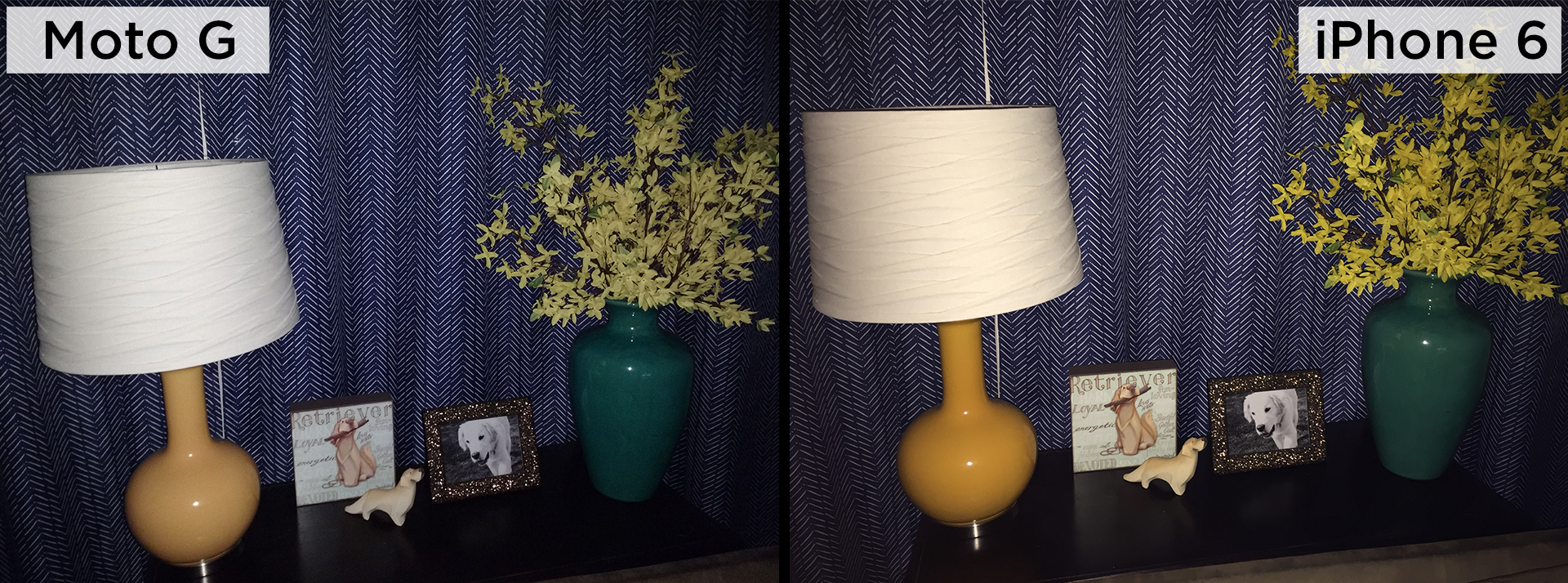
With the flash on, the Moto G struggled a bit versus the iPhone 6. A black-and-white photo of a golden retriever was a little blue, and the yellow on the flowers and the lamp looked duller and less vivid when compared to the iPhone's photo.
The 5-MP front camera didn't take the best shots. My selfies appeared to have a gray film over them, causing my skin and hair to look dull. On the flip side, the Blu Life One accurately captured the faint hints of my blush and self-tanner.
MORE: Best Camera Phone
One of the features I love about the Moto G's camera is Quick Capture. Using Moto Actions, you can twist your wrist twice to trigger the phone's camera, opening it even when the display is locked. It is hyper-sensitive, though; the Moto G once fired up the camera when I clumsily took the phone out of my bag.
Battery Life
The Moto G will carry you through the day and then some. Its 2470-mAh battery lasted 9 hours on our test, which involves Web surfing over LTE at 150 nits of brightness.
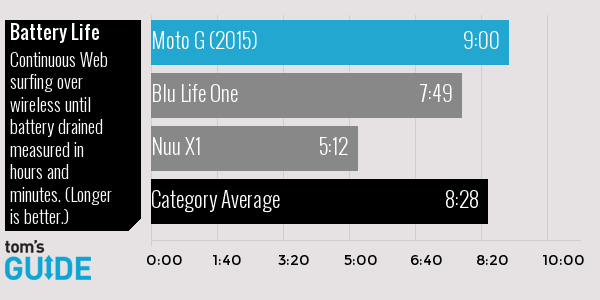
That's better than the smartphone category average (8:28), the Blu Life one (7:49) and the Nuu X1 (5:12). The Moto G also has TurboCharge technology, which should give you up to 10 hours of juice (Motorola's estimate) in just 15 minutes.
MORE: Smartphones with the Longest Battery Life
Bottom Line
The experience that the Moto G provides doesn't feel budget by any means. In fact, with its solid performance, long battery life and improved cameras, this is the best smartphone deal of the year. You could save money and opt for the $179 version, but we'd spend the extra $40 to get 16GB of storage and the extra 1GB of RAM for smoother performance. There are some other good phones in this price range, such as the Blu Life One, which has a lighter design and brighter screen. But the Moto G's water resistance, customizable design and longer endurance put it over the top.
- Smartphone Interactive Buying Guide
- Cellphone Insurance: The Best and Worst Plans
- Mobile Wallets: Apple Pay vs. Google Wallet vs. Samsung Pay
Valentina is Commerce Editor at Engadget and has covered consumer electronics for a number of publications including Tom's Guide, Wired, Laptop Mag and Ars Technica, with a particular focus on wearables, PCs and other mobile tech.


